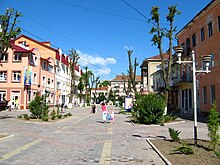Nadwirna
| Nadwirna | ||
| Надвірна | ||

|
|
|
| Basic data | ||
|---|---|---|
| Oblast : | Ivano-Frankivsk Oblast | |
| Rajon : | Nadvirna district | |
| Height : | no information | |
| Area : | 25.53 km² | |
| Residents : | 20,620 (2004) | |
| Population density : | 808 inhabitants per km² | |
| Postcodes : | 78409 | |
| Area code : | +380 3475 | |
| Geographic location : | 48 ° 38 ' N , 24 ° 34' E | |
| KOATUU : | 2624010100 | |
| Administrative structure : | 1 city | |
| Address: | вул. Mazepi 29 78400 м. Надвірна |
|
| Statistical information | ||
|
|
||
Nadvirna ( Ukrainian Надвірна ; Russian Надворная Nadwornaja , polish Nadvirna ) is a small town in the West Ukraine and the center of the same Rajons with 20,932 inhabitants ( census 2001). The city is located about 37 kilometers by rail or road in a south-southwest direction from the center of Ivano-Frankivsk Oblast .
Nadwirna lies at the foot of the Carpathian Mountains on the banks of the Bystryza River , has a rail connection and was granted city status in 1939 .
economy
Industry
In Nadvirna, the Ukrainian oil and gas group Naftohas Ukrajiny operates the "Надвірнанафтогаз" Nadwirnanaftohas refinery through its oil company ВАТ "Укрнафта" Ukrnafta .
traffic
From Nadwirna one of the few important road and rail connections leads across the Carpathian Mountains to Rakhiv in the Transcarpathian Oblast .
Local traffic is handled by buses and marshrutkas .
Railway lines
Between 1897 and 1968, the Nadwirna forest railway ran from the Sighetu Marmației – Ivano-Frankivsk railway in Nadvirna station in a south-westerly direction through the Bystryzja valley into the Carpathian forests to Selena and Bystryzja .
history
Nadworna largely shares the history of Ukraine and Galicia / Poland
The village was probably founded in 1596, when it was in the aristocratic republic of Poland-Lithuania in the Ruthenian Voivodeship. After the first partition of Poland in 1772, the city fell to Austria, from 1850 it was the seat of the district administration Nadwórna and a district court from 1867. After the end of the First World War , the place fell to Poland in 1919 and was from 1921 in the Stanislau voivodeship . In 1939, at the beginning of World War II , it fell to the Ukrainian SSR . In the 1930s there was increased activity in the region by the Ukrainian nationalist movement OUN under Stepan Bandera . From 1941 to 1944 Nadworna was occupied by the German Wehrmacht and then fell back to the Soviet Union.
Under the direction of Hans Krüger , members of the German security police station Stanisławów carried out a mass shooting of Polish Jews in Nadwirna on October 6, 1941, and another on the so-called Bloody Sunday of October 12 on the outskirts of Stanisławów. More than 10,000 people were killed in these two murders; of which probably 1200 to 2000 in Nadwirna. After the collapse of the Soviet Union in 1991, the city became part of independent Ukraine.
Daughters and sons of the city
- Jadwiga Wołoszyńska (1882–1951), Polish botanist
- Ljubomyr Polatajko (* 1979), cyclist
- Roman Hontjuk (* 1984), judoka
Twin cities
literature
- Nadwórna , in: Guy Miron (Ed.): The Yad Vashem encyclopedia of the ghettos during the Holocaust . Jerusalem: Yad Vashem, 2009 ISBN 978-965-308-345-5 , pp. 509f.
Web links
- http://www.kresy.co.uk/nadworna.html
- http://www.naftogaz.com/
- Soviet map (as of 1990)
- Nadworna . In: Meyers Konversations-Lexikon . 4th edition. Volume 11, Verlag des Bibliographisches Institut, Leipzig / Vienna 1885–1892, p. 975.
Individual evidence
- ↑ https://narrow.parovoz.com/UAIF.php
- ^ Local history of Nadvirna in the history of the cities and villages of the Ukrainian SSR ; accessed on November 6, 2017 (Ukrainian)
- ↑ Rizzi Zannoni, Woiewodztwo Ruskie, Część Krakowskiego, Sędomirskiego Bełzkiego y z y granicami Węgier, Polski, Które gory Karpackie nakształt łańcucha wyciągnione, od góry Wolska aż do Talabry, wyznaczaią .; 1772
- ^ Reichsgesetzblatt of October 8, 1850, No. 383, page 1741
- ↑ Klaus-Peter Friedrich (edit.): The persecution and murder of the European Jews by National Socialist Germany 1933–1945 (source collection) Volume 9: ' Poland: Generalgouvernement August 1941–1945 , Munich 2013, ISBN 978-3-486-71530 -9 , p. 20.


